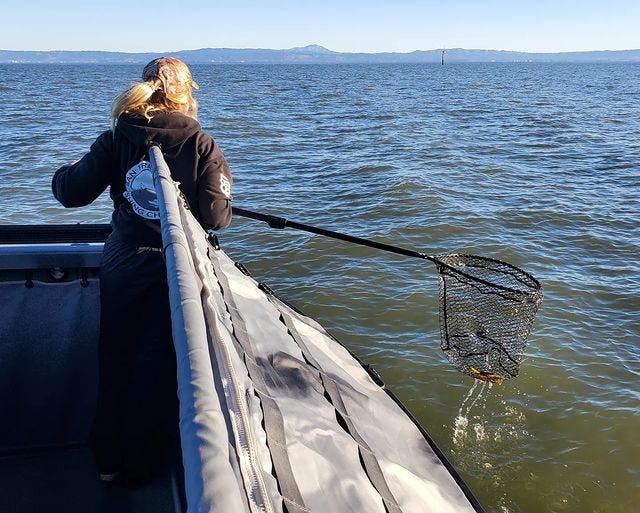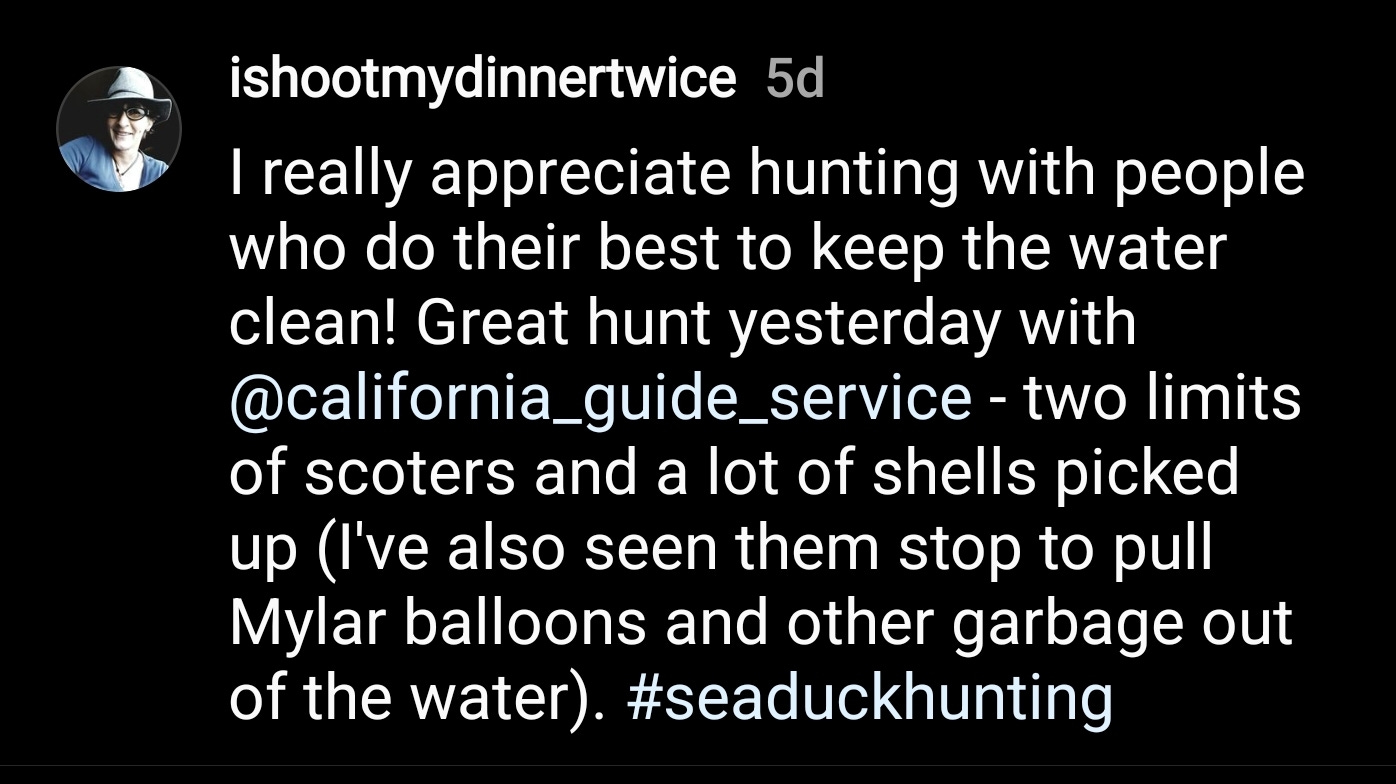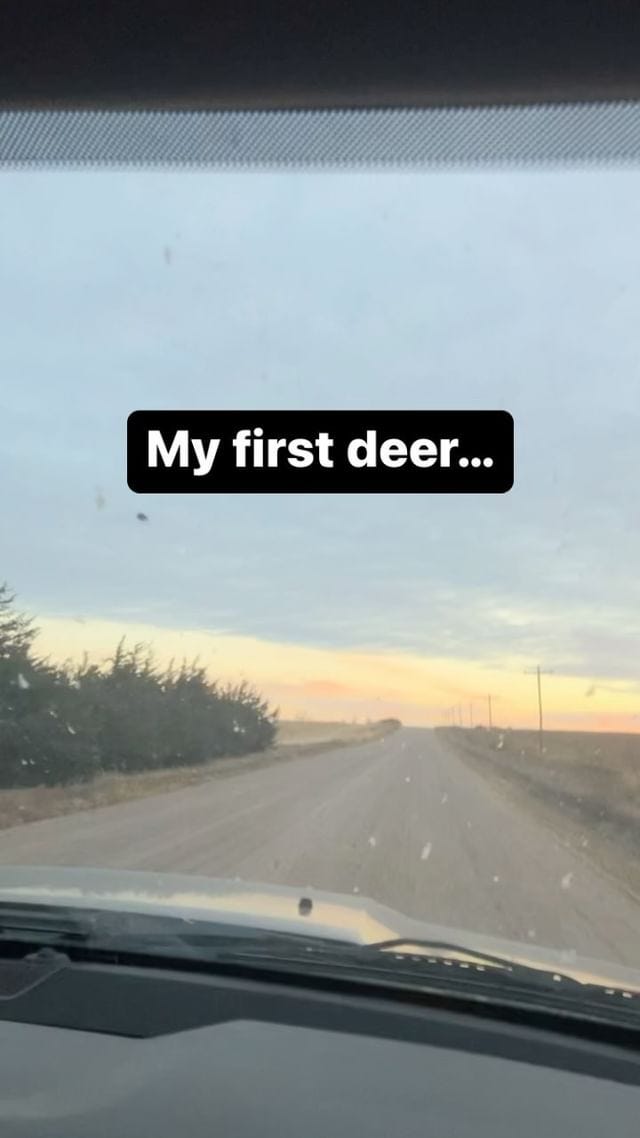People Are Watching
What are we showing them?
Can you find the seven dead surf scoters in this Instagram post?
No? OK, click on the post so you can see the whole thing. They’re there, just not in the way we’ve come to expect these days.
This Instagram post represents my evolution away from the “hero shot,” spurred by a lot of listening and looking at data about how people react to photos of hunters grinning with animals they’ve killed. For many, it might as well be a shot of someone grinning in front of an open casket at a funeral.
I understand hunting hero shots: They are mementos of successful hunts. I can defend those photos: They represent a mere sliver of the experiences that hunters savor on any given day. Hell, I take those photos, and I still include them with other hunting shots on my (friends-only) Facebook page and occasionally on Instagram.
I’m not going to pretend that a successful hunt doesn’t make me happy.
But I really don’t want those photos to dominate my Instagram feed during hunting season, because that feed is visible to everyone. If dead-animal photos are all that people see of our hunts, it can reinforce the perception that the kill is the only thing that matters about our hunts.
It’s tempting to growl about being restrained by the ignorance of non-hunters. They are, after all, an anomaly in the greater span of human history.
But a new book by my friends Jan Dizard and Mary Zeiss Stange, “Hunting: A Cultural History,” reframed this for me.
Jan and Mary make a compelling case that humans have always viewed hunting with mixed emotions because we know it ends the life of a fellow animal. We’ve always had societal rules dictating acceptable behaviors and attitudes for hunters. You need look no further than any hunter-gatherer culture’s hunting rituals to see this.
Now, the stakes of meeting those expectations have never been higher: Hunters are such a small minority that we can be extinguished by a majority if they collectively find our behavior unacceptable.
The graph below shows that only one in four people surveyed felt hunters should not be allowed to post photos of their kills on social media. This may seem like a safe margin, but that big middle column can contain plenty of people who are turned off by such photos, but would stop short of a ban. And if you pay close attention to any legislative (or electoral) process, you know that vocal, angry minorities - on the left and the right - have a LOT of say in the outcomes of big decisions.

Modern North American hunters have plenty of rules to follow, but the rules focus on protecting the health of wildlife populations, which has worked incredibly well. Game species - and many others in their habitats - thrive because hunters take care of the resource that takes care of us.
But with the exception of wanton waste laws, the amount of respect we show to the animals we hunt, and the ways we show it, are largely left up to individual hunters.
My friend Rue posts sparingly about her hunts, with no close-up gore, and often more subtle depictions of dead animals. Like sex in the movies in the old days, a hint tells the story just fine.
(Photo by @heritage_andreabogard)
Rue posts more photos of the game she’s cooking than the game she’s just killed, and that has had a significant impact in her social media circles: Her friends and fans see that hunting is about much more than killing, and they are following her into it, buoyed by her example (“if she can do it, so can I”) and likely heartened to see that hunting hasn’t turned her into a monster. And that toting a gun doesn’t mean dropping the lipstick.
Is she reversing the decline in hunter numbers? Doubtful - on the whole, they continue to fall. But for every one person who sees her posts and takes steps to begin hunting, there are probably at least a hundred more who see hunting in a more positive light.
That’s important. I don’t need everyone to hunt - my places are crowded enough as it is. I just need non-hunters not to fall for the caricatures peddled by anti-hunting groups, because that’s how hunting gets taken away from us, bit by bit.
And that means it behooves us not to play into those caricatures.
On my hunts, I’m increasingly looking to share other moments I savor: pretty light, the play of colors and shapes in the marsh, sometimes a close-up of feathers. And in the case of the Instagram post that kicked off this whole piece, other messages I want people to hear.
In case you didn’t click over, here’s the text of that post:
If you visit the edges of San Francisco Bay, or any hunted marsh or rice field inland, you will find shotshells and wads at water’s edge. When non-hunters see that, it’s easy for them to assume hunters must be lazy, littering assholes.
No doubt, some are. But the reality is it’s extremely hard to pick up all your spent shells because they float away or get lodged where you can’t see them, and hard to recover any of your wads because they fly so far from the gun.
When hunting inland, I pick up what I can, both my own and other hunters’. But picking up shells on an open bay with strong currents is virtually impossible, because they float away from the boat really fast.
A big, open bay is where we were hunting in the Instagram post. That’s why I was so happy to see our guide and her assistant scooping up spent shells that day.
And that’s why I was very happy to share that with the world in the Instagram post. There are organizations that wouldn’t hesitate to ban all plastics in shotshells. They don’t care that we lack alternatives in any meaningful numbers, in no small part because they think we don’t care about the impacts of plastics in the ocean.
I care, and so do a lot of other hunters I know.
Cynics might wonder if that shotshell pickup was a one-off act of playing to the camera. My first answer is I can’t know what goes on in people’s heads, or what they do when I’m not around.
The more important answer is: It might not matter.
Just about everything you see on social media and a lot of what’s left of hunting television right now is playing to the camera, including yells of “Hyuk hyuk hyuk, that’s what I’m tawlkin’ about” when ducks fall from the sky, huge piles of dead birds, and my favorite, piles of birds arranged to show the number of birds killed - an old Argentina dove-hunting standby.
For every one of those photos or video clips, some people see them and think, That’s cool!, and the next time they hunt, they want to do something just like it. I remember it clearly: The more you’d hear “that’s what I’m tawlkin’ about” on TV, the more you could hear it rippling across the marshes where I hunt. Humans are congenital copycats.
So if people want to play to the camera in a way that encourages respectful behavior, instead of making disrespectful acts seem cool, who am I to complain?
I don’t know how many people might be inspired by me, or my friend Rue, or Hank, when we post photos that tell a more complete story of our experiences afield - when we balance the very real joy of a successful hunt with the genuine respect for animals and nature that we also feel.
But if it’s anything north of zero, that works for me. Evolution in social media happens one person at a time. The perceptions of those who are watching us change at the same speed.
MORE READING (AND WATCHING)
In addition to Jan and Mary’s book, which I highly recommend, here are three more reads on similar or relevant topics:
One Photo, Two Images, a 2016 blog post by Hank about hero shots, prompted by Facebook rejecting an ad for one of his hunting and cooking schools.
Which hunting photo is upsetting? A 2010 blog post of mine about three of my photos that ran in a food magazine, and the surprising (to me) one that really upset people.
Hunting - Philosophy for Everyone, a 2010 book with a variety of essays exploring hunting. Two chapters in particular informed the views you see in today’s post: “Chapter 9: Living with Dead Animals? Trophies as Souvenirs of the Hunt” and “Chapter 11: The Fear of the Lord: Hunting as if the Boss is Watching.” I also reviewed this book in detail on my old blog.
Finally, I had already scheduled this piece when I saw my friend Sage’s Instagram post below about his first deer, a video that encapsulates both the work and the respectful joy of the hunt. I like it.






A solid reprise of a fairly timeless topic... and I think you know I'm pretty much aligned with you on this. I believe hunting survives on the graces of public opinion and the democratic process (although I believe a general public apathy may play a frighteningly large part as well... one reason a vocal minority carries so much sway). It behooves us to consider our entire audience, intended or otherwise, when we share our stories. We should be honest, but being honest doesn't mean we can't be mindful.
But aside from that, you bring up interesting points re: the shotshells and wads, or more importantly, how that looks to non-hunters and non-shooters.
I'm "tangentially" involved with an organization called Plastic Ocean Project (POP), which as you probably deduced, is focused on removing plastic pollution from our oceans and waterways. Like most activist organizations, a large contingent of this one consists of idealistic young people. They are motivated and engaged and driven by the mission... but their world view is limited to their own experience (or lack thereof).
In a discussion on their Facebook page, someone started in on how some thoughtless, asshole, skeet shooters were littering the waterfront with shotgun shells and wads... and how if they couldn't be bothered to clean these up, they should be banned from shooting over water. Other voices chimed in with calls to ban plastic shotgun shells altogether.
It was an interesting, but unsurprising, opportunity to see this perspective. On the one hand, it's absolutely true that most shotgunners don't give a second thought to what happens to the plastic shot wads they send out into the environment. And I have to agree that shotgunners who can't be bothered to pick up their empties (when it's practicable) kind of are assholes. The more we learn about plastics in the marine environment, the more impactful these "little" things appear to be.
On the other hand, as I tried to explain in that conversation (with more success than you might expect), the picture is not quite as clear-cut as it may appear. Like you called out, Holly, it's not always possible to recover your empties when shooting over water. Collecting the spent wads is practically impossible... especially if you factor in wind and current, and the fact that the wads often sink pretty quickly. So finding the shot wads in the marsh is not de facto evidence of assholery.
I also explained sort of why we have plastic shotshells and some general challenges to switching away from plastic... but that's not my point.
The point is that these young people, activists, reacted to what they saw through the lens of their own experience. What they saw wasn't good. What's worse is that this "evidence" aligned with their preconceptions about guns and shooting.
What they're not seeing (enough) is examples like you have here... the guides cleaning up the waterway, trying to leave it a little better than they found it. They don't usually see hunters picking up trash along the trail, or cleaning up the trailheads after someone left a mess. They don't often see fishing boat captains out there plucking balloons, bottles, and other crap out of the ocean.
All of these things happen pretty regularly, but folks aren't seeing it.
I don't know, but maybe they should? Maybe we could start to share those trophy shots of the bag of trash we collected at the trailhead, or the string of mylar birthday balloons we pulled out of the ocean. Mix them in with the grip-n-grin hero shots on social media...
Or something.
Thanks for this, Holly. I'm always super hesitant to post dead-animal shots on social media, and I recently had the vague idea that I could start posting food shots instead -- but I hadn't actually lined up the WHY until I read this post. It suddenly clicked for me that being extra-intentional in this way means I don't just avoid upsetting people, I also have a chance to actively shift perceptions of what hunting can mean. I appreciate the shift moment.